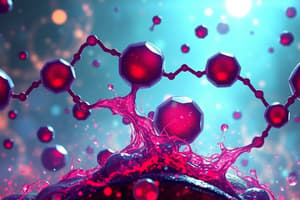Podcast
Questions and Answers
What is the primary function of heme in the body?
What is the primary function of heme in the body?
- Protein synthesis in muscle tissue
- Energy storage in liver cells
- Hormone regulation in erythrocytes
- Oxygen transport and electron transfer (correct)
Which of the following best describes Chronic Hepatic Porphyria?
Which of the following best describes Chronic Hepatic Porphyria?
- Deficiency in uroporphyrinogen decarboxylase leading to uroporphyrin accumulation (correct)
- Increased synthesis of hemoglobin due to erythropoietin
- Excess heme production resulting in elevated iron levels
- Genetic mutation affecting vitamin D metabolism
What effect does high concentrations of heme have on ALA synthase activity?
What effect does high concentrations of heme have on ALA synthase activity?
- Has no effect on ALA synthase activity
- Activates all porphyrin synthesis pathways
- Decreases ALA synthase activity (correct)
- Increases ALA synthase activity
Which of the following enzymes is implicated in the most common type of porphyria?
Which of the following enzymes is implicated in the most common type of porphyria?
What is a symptom associated with the accumulation of porphyrins in the skin?
What is a symptom associated with the accumulation of porphyrins in the skin?
In which organ is heme primarily synthesized, particularly for cytochrome P450?
In which organ is heme primarily synthesized, particularly for cytochrome P450?
What impact do drugs like phenobarbital have on ALA synthase activity?
What impact do drugs like phenobarbital have on ALA synthase activity?
What is the role of erythropoietin in erythrocytes regarding heme synthesis?
What is the role of erythropoietin in erythrocytes regarding heme synthesis?
Which type of porphyria is characterized by a deficiency in hydroxymethylbilane synthase?
Which type of porphyria is characterized by a deficiency in hydroxymethylbilane synthase?
What accumulates in the urine of patients with hereditary coproporphyria?
What accumulates in the urine of patients with hereditary coproporphyria?
Which of the following porphyrias is associated with patients becoming photosensitive?
Which of the following porphyrias is associated with patients becoming photosensitive?
Which treatment is indicated for reducing pain and vomiting in porphyria patients?
Which treatment is indicated for reducing pain and vomiting in porphyria patients?
In which condition does ALA and porphobilinogen accumulate in urine?
In which condition does ALA and porphobilinogen accumulate in urine?
What is the primary mechanism causing pathology in porphyrias?
What is the primary mechanism causing pathology in porphyrias?
Which of the following statements is TRUE regarding variegate porphyria?
Which of the following statements is TRUE regarding variegate porphyria?
Which condition results in patients having photosensitivity due to porphyrin accumulation?
Which condition results in patients having photosensitivity due to porphyrin accumulation?
Flashcards
Porphyrins
Porphyrins
Cyclic molecules composed of four linked pyrrole rings connected by methenyl bridges. They have various side chains attached to the pyrrole rings, determining their specific type.
Heme
Heme
A metalloporphyrin with iron (Fe2+) coordinated at its center. It is a prosthetic group vital for proteins like hemoglobin, myoglobin, and cytochromes.
Heme Biosynthesis
Heme Biosynthesis
The process of synthesizing heme, which occurs primarily in the liver and erythrocyte-producing cells of the bone marrow. It involves multiple enzymatic reactions, with the initial and final steps taking place in mitochondria.
End-Product Inhibition by Hemin
End-Product Inhibition by Hemin
Signup and view all the flashcards
Effect of Drugs on ALA Synthase
Effect of Drugs on ALA Synthase
Signup and view all the flashcards
Porphyrias
Porphyrias
Signup and view all the flashcards
Porphyria Cutanea Tarda
Porphyria Cutanea Tarda
Signup and view all the flashcards
Types of Porphyrias
Types of Porphyrias
Signup and view all the flashcards
Acute Intermittent Porphyria (AIP)
Acute Intermittent Porphyria (AIP)
Signup and view all the flashcards
Hereditary Coproporphyria
Hereditary Coproporphyria
Signup and view all the flashcards
Variegate Porphyria
Variegate Porphyria
Signup and view all the flashcards
Erythropoietic Protoporphyria (EPP)
Erythropoietic Protoporphyria (EPP)
Signup and view all the flashcards
Congenital Erythropoietic Porphyria (CEP)
Congenital Erythropoietic Porphyria (CEP)
Signup and view all the flashcards
δ-Aminolevulinic Acid (ALA) Synthase
δ-Aminolevulinic Acid (ALA) Synthase
Signup and view all the flashcards
Treatment of Porphyrias
Treatment of Porphyrias
Signup and view all the flashcards
Study Notes
Porphyrias Overview
- Porphyrias are inherited genetic diseases
- They involve defects in heme synthesis
- These defects cause accumulation and increased excretion of porphyrins or porphyrin precursors
Porphyrin Structure
- Porphyrins are cyclic molecules
- Formed by the linkage of four pyrrole rings
- Connected via methenyl bridges
- Have side chains attached to the pyrrole rings
- Different porphyrins have different side chains (e.g., uroporphyrin with acetate and propionate chains, protoporphyrin IX with vinyl, methyl, and propionate groups)
- Heme is a metalloporphyrin
- Fe²⁺ is coordinated in the center of a protoporphyrin IX ring
- Heme is a prosthetic group for hemoglobin, myoglobin, and cytochromes
Heme Biosynthesis
- Synthesized in the liver and erythrocyte producing cells in bone marrow
- Liver synthesis varies depending on cellular heme pool
- Erythrocyte synthesis is constant, matching globin synthesis
- First reaction and last three steps occur in mitochondria, remaining steps in the cytosol
Porphyria Regulation
- End product inhibition by hemin: Heme production exceeds the availability of globin or other apoproteins, leading to heme accumulation and oxidation to hemin. Hepatic ALA synthase activity decreases. Erythropoiesis is affected by erythropoietin and intracellular iron.
- Effect of drugs on ALA synthase: Drugs like phenobarbital, griseofulvin, and hydantoins increase hepatic ALA synthase activity because they stimulate cytochrome P450 monoxygenase system activity, which uses heme. Heme concentration in liver cells decreases, stimulating ALA synthase.
Types of Porphyrias
Chronic Hepatic Porphyria (Porphyria cutanea tarda)
- Most common type
- Deficiency in uroporphyrinogen decarboxylase
- Uroporphyrin accumulates and is excreted in the urine
- Symptoms include photosensitivity (skin itching and burning due to porphyrin-mediated superoxide radicals) and red-to-brown urine
Acute Hepatic Porphyrias
Acute Intermittent Porphyria
- Deficiency in hydroxymethylbilane synthase
- ALA and porphobilinogen accumulate in the urine
- Urine darkens with exposure to air or light
- Patients are not photosensitive
- Symptoms include abdominal pain, and symptoms are aggravated by barbiturates
Hereditary Coproporphyria
- Deficiency in coproporphyrinogen oxidase
- Coproporphyrinogen III and preceding intermediates accumulate in the urine
- Patients are photosensitive
Variegate Porphyria
- Deficiency in protoporphyrinogen oxidase
- Protoporphyrinogen IX and preceding intermediates accumulate in the urine
- Patients are photosensitive
Erythropoietic Porphyrias
Erythropoietic Protoporphyria
- Deficiency in ferrochelatase
- Protoporphyrin IX cannot chelate with Fe²⁺ to form heme
- Protoporphyrin accumulates in erythrocytes, bone marrow, and plasma
- Patients are photosensitive
Congenital Erythropoietic Porphyria
- Deficiency in uroporphyrinogen III synthase
- Uroporphyrinogen I and coproporphyrinogen I accumulate in the urine (intermediates preceding the block)
- Patients are photosensitive
Porphyria Characteristics
- Porphyrias result in decreased heme synthesis
- Heme is a repressor of ALA synthase
- Absence of heme increases ALA synthase activity
- Synthesis of intermediates before the genetic block increases
- Accumulation of toxic intermediates causes porphyria pathology
Porphyria Treatment
- Treatment for pain and vomiting
- Intravenous hemin injection (decreases ALA synthase)
- Avoidance of sunlight for photosensitivity
- Ingestion of β-carotene (free radical scavenger)
Porphyria Diagnosis (Summary)
- A table summarizing the porphyria types, deficient enzymes, abnormal porphyrin concentrations, and photosensitivity status found for each.
Studying That Suits You
Use AI to generate personalized quizzes and flashcards to suit your learning preferences.




